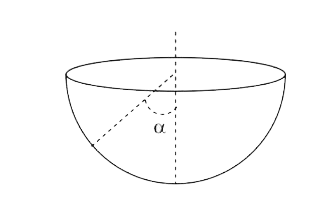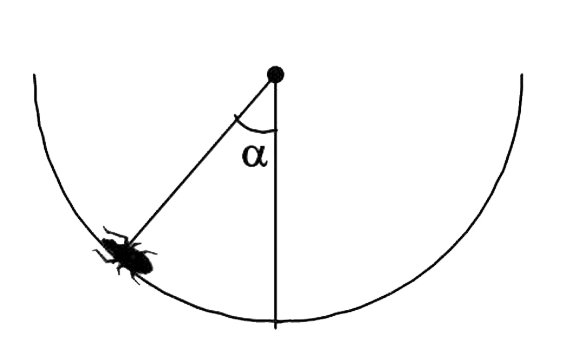If the coefficient of friction between an insect and bowl is μ and the radius of the bowl is r, find the maximum height to which the insect can crawl in the bowl.
To solve the problem of finding the maximum height to which the insect can crawl in a bowl, we can follow these steps:
Step 1: Understand the Geometry of the Problem
- The bowl is a sphere with a radius r.
- The insect crawls up the inner surface of the bowl, reaching a height h from the bottom.
- The angle θ is formed between the vertical line from the center of the bowl to the insect and the line from the center to the insect's position.
Step 2: Relate Height and Angle
- The height h that the insect reaches can be expressed in terms of the radius r and the angle θ:
h=r−rcosθ=r(1−cosθ)
Step 3: Analyze Forces Acting on the Insect
- The weight W of the insect acts downward.
- The normal force N acts perpendicular to the surface of the bowl.
- The frictional force f acts parallel to the surface of the bowl, opposing the motion of the insect.
Step 4: Set Up the Equations of Motion
- The components of the weight can be expressed as:
- Wcosθ acts perpendicular to the surface (providing the normal force).
- Wsinθ acts parallel to the surface (which is opposed by the frictional force).
- The normal force N is equal to the component of the weight acting perpendicular to the surface:
N=Wcosθ
Step 5: Apply the Friction Condition
- The frictional force f can be expressed as:
f=μN=μWcosθ
- For the insect to not slip, the frictional force must be equal to the component of weight acting down the slope:
Wsinθ=μWcosθ
- Dividing both sides by W (assuming W≠0):
tanθ=μ
Step 6: Relate Cosine and Tangent
- From the tangent relation, we can express cosθ:
cosθ=1√μ2+1
Step 7: Substitute Back to Find Height
- Substitute cosθ back into the height equation:
h=r(1−cosθ)=r(1−1√μ2+1)
- Simplifying gives:
h=r(1−1√μ2+1)
Final Result
The maximum height h to which the insect can crawl in the bowl is:
h=r(1−1√μ2+1)
- The bowl is a sphere with a radius r.
- The insect crawls up the inner surface of the bowl, reaching a height h from the bottom.
- The angle θ is formed between the vertical line from the center of the bowl to the insect and the line from the center to the insect's position.
- The height h that the insect reaches can be expressed in terms of the radius r and the angle θ:
h=r−rcosθ=r(1−cosθ)
- The weight W of the insect acts downward.
- The normal force N acts perpendicular to the surface of the bowl.
- The frictional force f acts parallel to the surface of the bowl, opposing the motion of the insect.
- The components of the weight can be expressed as:
- Wcosθ acts perpendicular to the surface (providing the normal force).
- Wsinθ acts parallel to the surface (which is opposed by the frictional force).
- The normal force N is equal to the component of the weight acting perpendicular to the surface:
N=Wcosθ
- The frictional force f can be expressed as:
f=μN=μWcosθ
- For the insect to not slip, the frictional force must be equal to the component of weight acting down the slope:
Wsinθ=μWcosθ
- Dividing both sides by W (assuming W≠0):
tanθ=μ
- From the tangent relation, we can express cosθ:
cosθ=1√μ2+1
- Substitute cosθ back into the height equation:
h=r(1−cosθ)=r(1−1√μ2+1)
- Simplifying gives:
h=r(1−1√μ2+1)
The maximum height h to which the insect can crawl in the bowl is:
h=r(1−1√μ2+1)
Topper's Solved these Questions
- NEWTONS LAWS OF MOTIONBOOK - ALLENCHAPTER - NEWTONS LAWS OF MOTIONEXERCISE - EXERCISE-I
52 Videos
- NEWTONS LAWS OF MOTIONBOOK - ALLENCHAPTER - NEWTONS LAWS OF MOTIONEXERCISE - EXERCISE-II
112 Videos
- NEWTONS LAWS OF MOTIONBOOK - ALLENCHAPTER - NEWTONS LAWS OF MOTIONEXERCISE - EXERCISE-III
28 Videos
- NEWTON'S LAWS OF MOTION & FRICTIONBOOK - ALLENCHAPTER - NEWTON'S LAWS OF MOTION & FRICTIONEXERCISE - EXERCISE (JA)
4 Videos
- RACEBOOK - ALLENCHAPTER - RACEEXERCISE - Basic Maths (Wave Motion & Dopplers Effect) (Stationary waves & doppler effect, beats)
24 Videos
Similar Questions
A particle is placed at rest inside a hollow hemisphere of radius R. The coefficient of friction between the particle and the hemisphere is μ=1√3. The maximum height up to which the particle can remain stationary is
View SolutionAn insect of mass m is initially at one end of a stick of length L and mass M, which rests on a smooth floor. The coefficientg of friction between the insect and the stick is k. The minimum time in which the insect can reach the other end of the stick is t. Then t2 is equal to
View SolutionIf the coefficient of friction between A and B is μ, the maximum acceleration of the wedge A for which B will remain at rest with respect to the wedge is

View SolutionIf the coefficient of friction between A and B is μ, the maximum acceleration of the wedge A for which B will remain at rest with respect to the wedge is

View SolutionAn insect crawls up a hemispherical surface very slowly. The coefficient of friction between the insect and the surface is 1/3. If the line joining the centre of the hemispherical surface to the insect makes an angle α with the vertical, the maximum possible value of is given by:

View SolutionAn insect craws up a hemispherical surface very slowly (see fig.). The coefficient of friction between the insect and the surface is 1/3. If the line joining the center of the hemispherical surface to the insect makes an angle α with the vertical, the maximum possible value of α is given by

View SolutionAn insect craws up a hemispherical surface very slowly (see fig.). The coefficient of friction between the insect and the surface is 1/3. If the line joining the center of the hemispherical surface to the insect makes an angle α with the vertical, the maximum possible value of α is given by

View SolutionAn insect craws up a hemispherical surface very slowly (see fig.). The coefficient of friction between the insect and the surface is 1/3. If the line joining the center of the hemispherical surface to the insect makes an angle α with the vertical, the maximum possible value of α is given by

View SolutionThe friction coefficient between the board and the floor shown in figure is μ Find the maximum force that the man can exert on the rope so that the board does not slip on the floor

View SolutionA car has to move on a level turn of radius 45 m. If the coefficient of static friction between the tyre and the road is μs=2.0, find the maximum speed the car can take without skidding.
View Solution
